Introduction
The Leica M3 was introduced in 1954, but the camera was available for testing in 1953 (60 lucky individuals got one!). Instantly the camera became a success and we may wonder why, if we look at the specs from todays elevated demands. At the start of the second golden age for the mechanical precision rangefinder camera, this model with four-lug bayonet fitting, clear and large viewfinder with selectable framelines, and the new film advance lever, a rapid wind lever with two strokes. The shutter can be released at the end of the advance stroke which allows for a fast operation. You need to practice this as the finger acrobatics are complicated. The Leitz people decided upon the shape of the lever after a lengthy study and some claim that there never has been a better shape. The shutter speed dial was a single click-stopped one, nonrotating and could be coupled with a clip-on exposure meter. Modest as these details seem today, for the working photographer they were a major advantage for improving the quality, style and range of their photography.
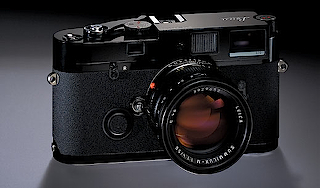
The mechanical quality of the M3 was an important aspect of the photographer's trust and confidence in the instrument. This quality could be seen in the elaborate surface shape and details in the rewind knob, frame selector, self timer lever and rewind lock level, and experienced in the very tight fit, coupled with an unsurpassed silky smooth operation of the moving parts.
The M3 was up to date during more than a decade, but the photographic scene changed in the direction of a more close-up and intimate style of photography, strongly promoted by people like David Bailey, who set the pace for the Swinging Sixties in fashion and reportage photography. Gradually the photographers wanted more automated features, and not because they did not care for the craft of the trade! With some automation, they could concentrate on the recording of the scene without any interruption.
Leica engineers were and are a very cautious and deliberate species and followed these trends was a wider time gap. Developed in stages (M5 and M6) with the current M7 they have introduced a camera that is highly efficient and delivers a fine functionality for most styles of photography. It was clear when detailing the specs for the M7, that the M6TTL had to go as they overlap substantially, but on the other hand it was evident that the M7 had strayed a bit too wide from the original roots in its evolution. Some observers complain about the battery dependance of the M7 and its (moderate) amount of electronically controlled functions.
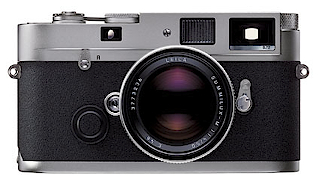
This is the wrong view in my opinion: battery dependance has never been a hindrance to the working photographers who with their Nikon F5 and Canon EOS1 roam the desolate deserts and tropical rain forests to capture whatever catches their eye. Nor are electronical components unreliable when produced with care and the right choice of materials.
There is a case for a camera that is mechanically controlled and that is the feeling of the mechanical components working under load and the precise, sensitive feedback of the controls when being operated. Here one can find the roots of the MP.
Back to the future: the MP
Superficially considered, the MP, with the functionality of the original M6 (classic M6) makes little sense as there are already 135.000 M6 and about 50.000 M6TTL on the market.. The camera is available in silver chrome in all three rangefinder versions (0.58, 0.72 and 0.85) and in black paint only with the 0.72 finder. The new model has been launched first in Japan with a special version, called MP6 in a small batch of 400 cameras. The MP symbols stands for Mechanical Perfection. The tradition of the M4P designation has not been extended and Leica has returned to the original symbol from the M3 period, when the MP was the M3 with integrated Leicavit.
The significance of the MP goes beyond the mere specs. Let us first describe the specifications. It is has a fully mechanically controlled cloth shutter with speeds from 1 sec to 1/1000. There has been much discussion about this topspeed and the need for higher speeds. The situation is quite simple: the horizontally running shutter with cloth blinds cannot exceed the 1/2000. Above this speed the slit becomes so small that you will get interference bands on the film plane. The Leica M utilizes a three axis design (the Leicaflex and the Canon F1 had four axis designs) and the relatively short traveling distance across the body length sets limits to the braking distance and so we cannot get a higher speed with this design.
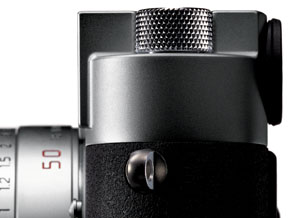
The TTL exposure metering has the same functionality as we know from the M6: see specs at the end of this report. The exposure method is the integral measuring of a small area of the negative frame. The white reflective spot on the first curtain corresponds to an image area that extends 6mm from the axis. While Leica calls this method a selective metering, it is better to refer to this as a small area integral metering to evade the association with a spot or semi-spot metering method. The Leica exposure metering is quite effective and reliable, but not foolproof. Some analysis of the scene in relation to the exposure method is always helpful.
The topcover is manufactured out of a solid piece of brass as is the case with the M7 topcover. This one is 2.5mm lower and in dimensions identical to the original M6 topcover. The glass windows are flush with the body ad do not have the protrusions of the M3. And there is no identification on the front of the cover. On the top we find the classically styled Leica name and the serial number has moved from the hotshoe to the topcover. While these changes are non-functional, they do give the MP a very classical and elegant look as to stress the basic simplicity of the mechanical internals.
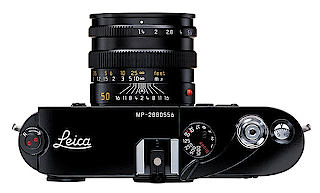
The body is covered with a new very fine grained material offes an excellent grip and is superior to the old Vulcanite and the current material. During a three day use of the camera, I did not miss the additional handgrip. The materal has a faint feeling of softness and seems to breath a bit. When your hands are slippery from warm weather and/or excitement this cover still can be grasped firmly.
The black paint (lacquer) version looks beautiful and inspires the user to strive for the best possible photography. The black paint is meant to wear and so to give the camera a worn look. My version already showed some wear after some days. The MP is evidently a camera you buy and will never sell, because it becomes a tool with a history tightly coupled to its original buyer.
On the front we see the frame selector, lens lock button and rewind lock, closely modelled to the M3 style.
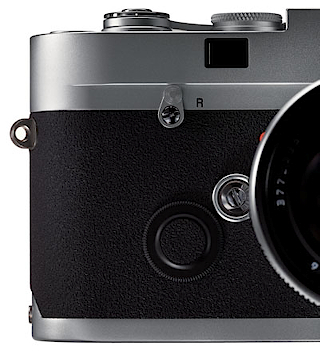
These rounded components fit the body style, but the more squarish ones form the M7 are pleasing too. This is a matter of taste. The rewind knob and the advance lever in M3 style are more important from a functional point of view. The MP is profiled as a professional camera and the automatic connotation with 'professional' is a high film consumption. By implication that seems to point to the situation where a reportage photographer needs to switch film fast and often in the middle of a shooting session. The pull-up rewind knob is squarely against this supposition. It is slow to operate and even with the additional M-rewind crank, film changing is not a very quick act. And its price is even for Leica hardened aficionados a stab in the eye. We will return to this topic later on in the report. But we should extent the notion of 'professional' to any photographer who uses his/her craft to get the required results without failure. An instrument that can be trusted at every instant of deployment and gives confidence during a long working life is quite useful.
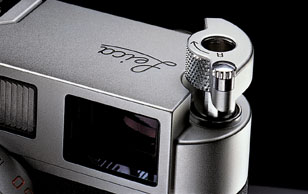
The advance lever will be a matter of some controversy too. The M4 type is ergonomically the better one, as the thumb will not slip off the tip of the lever at the end of the advance stroke and its standoff position is better. The M3 lever allows the thumb to be on the verge of slipping off and gives a somewhat less secure feeling when operating the lever. The answer might be that the MP has the new Leicavit when fast shooting is required. From a purist view the shape of the M3 lever is more in harmony with the body.
Internal changes
The MP is not the classical M6 with some M3 details added. Knowing the Leica people's drive for perfection, one would be surprised if they would not find areas for improvement. The important new fine grained bodycover has already mentioned.
Internally TTL electronics are new. The M6 electronics were a hybrid design and the mechanical/electronical interface was partly done by analogue electrical means. Now the electronics are fully digital (as in the M7) and have improved reliability and a lower battery consumption. There is now a battery warning signal to the right of the exposure diodes.
The shutter curtains are more light tight and the occasional light leaks of the older shutter curtains are now extinct. Even more important is the improved mechanical geometry of the shutter. As has been explained in the M7 review the shutter curtains have an acceleration and deceleration moment, when speed is building up and the curtain mass must be braked. Here we have an area of variable geometry and a careful redesign of the rollers and springs and braking elements has resulted in a very even movement over the travel length. Occasionally users have noted very small darker bands at the sides of the frame as a result of the shutter movement being too slow at the start and stop moments. With the new design there should be no problem.
The rewind knob has a very useful friction now. Every Leica user has experienced the following: you rewind the film and halfway your fingers slip. Then the force of the curled film pulls the rewound part back and you have to start all over. The MP rewind knob has been designed with an inherent friction that is equal to the film force. Now you can remove your fingers from the knob and the film stays where it is. I did try it during my test of the camera and it works.
Gears and other moving parts have been improved by a new shape and surface treatment, which will increase the mean time before failure and enhances the smoothness of the operation. The current manufacturing procedures and assembly methods allow for a slight tolerance in the selection of matching parts and some users, when comparing the M6 or M7 with a finely tuned M3 will notice a certain roughness when transporting the film or pressing the two way shutter release. With the MP there is no such thing: all operations are extremely smooth and in direct comparison to my M3 even show improvements in smoothness and noise reduction. I checked several MP models and all were alike.
The viewfinder has been improved too. The well-known flaring of the rangefinder patch under adverse light conditions since the M4-2 has been eliminated completely. As I am very sensitive to this phenomenon I compared my M7 in identical situations to the MP and could indeed notice that the MP has not the slightest propensity to flare where the M7 shows stray light in the finder patch. The technical solution is to enlarge the hole in the reflective mirror and add a lens element to the frameline holder. This is a most welcome improvement. Technically it can be fitted to older and current models and here Leica should make a clear statement.
In use
In use the camera is functionally the same as an M6, M6TTL or M7. The exposure metering system is identical and so the percentage of successful pictures is the same with all cameras. The noise level is identical too. The M7 of course has no long times escapement and the MP will have that subtle noise at speeds below 1/15 of a second. Functionally there is a draw.
When using the camera in the field, the situation is different. I used the camera during three days and mixed the MP with the M7 in identical situations. The city of Lyon was the location where Leica showed the MP to the press. The museum of Lumiere was the exact spot: Here the movies were born and it was Edison who created the movie film that we know today as the 35mm film. The films used were Kodak Ektachrome 100VS, 100G and Kodak RS200/400/800. Along the river there was an artist exhibition of painters and here the light situations, specifically in contre-jour light were fleeting and changing every split second. This is the domain of the M7 without doubt. When strolling through the old parts of the medieval inner city, the advantage of the M7 diminished and the MP started to shine.
I was quite sceptical of the camera when I handled one more than two years ago. But I have to revise my opinion. When you take the MP in your hands, there seems to flow an emotional charge through your hands to your brain and heart that forces you to take your photography to a higher level. The camera handles and functions so well mechanically, that pressing the shutter is such a conscious act of capturing the exact moment, that you are very eager to equate the excellence of your photographs to the excellence of the mechanixs. Such is the powerof using an exquisite tool that you feel a certain deception when your photos are not good enough to be taken with such a camera. And a drive to improve your photography at the same instant!
To sum up
The MP is a camera that you need to touch with your hands and to experience directly. The black laquer version has a very strong emotional signal that relates back to the original M3 and forces you to adjust your photography and photographic style. Photography is, as every creative act, partly an emotional activity and here the MP is paramount. Functionally close to and surpassed by the M7, this camera, the MP, strikes a chord in every disciplined photographer's heart by its pure mechanical operations.
The MP inspires confidence in your photography, and forces you to reconsider your approach to photography. As remarked above, the equation 'fast film change = professional' is not true as a general statement.There are many situations and photographic assigments (paid and self defined or nonpaid) where the 36 exposures on one roll of film will be sufficient for the task and when more exposures are needed. one can plan a break in the shooting session for reloading the MP or M7. I dwell a bit on this topic as there seems to be the assumption that Murphy's law will act when taking pictures, specifically when using Leicas. This law states that as soon as you have exposed your 36th negative, the best opportunity will pop up and you cannot photograph this. A first corrolary is that the best pictures will never be made because they will occur after you have exposed all your films. A second corrolary states that exposing film is useless as the good photo opportunities will always occur after you run out of films or exposures on a film.
The MP is the camera for photographers who want to and can control their photograpy completely. They are masters of the craft of photography and therefore can command the situation and anticipate on coming events and acts. This mastery of craft and anticipation of the dynamics of the situation, will be more secure and, let us face it, more enjoyable when the tool is in harmony with these goals. A fully manual and mechanical camera that, fitting in your hands, translates your aims with the smooth precision of a finely tuned instrument, has added value. We know that an electronically controlled shutter has more accurate speeds than a mechanically controlled one. But the deviations of the mechanical shutter are so small as to not noticeable on most occasions. The shutter mechanism at work inside the body is a masterpiece of engineering where springs, gears and shafs and ballbearings are made of highgrade steel with meticulous surface treatment and assembled with a tight fit. This cannot be seen, but it can be sensed and heard. It is supported by the metal controls of the camera, that are also treated with great care to transcend the workmanlike quality inside the camera. And these qualities are experienced during picture taking and they subconsciously force the user to aim for a higher level of image quality. When taking pictures with the MP, I could detect this feeling inside myself. The MP radiates a very strong and emotional signal of photographic competence.
The choice
The M7 and the MP. Two quite desirable instruments and both have their role and position in the Leica world. Ideally you would want to have both: one for the logic and efficiency, the other for the emotion and the style. But not everyone can afford to buy both. Which one to choose? When we look at the digital world and its developments, such a question would be one for Trivial Pursuits. When we seach for a tool that can fathom the essence of photography as a craft, the MP would be the instrument of choice. Leica succeeded in creating a tool, a camera, that is as emotional as an M3 and surpasses that camera in its engineering and mechanical qualities.The MP is more limited in its functionality than the M7. The MP will suit the photographer who as a first step mentally creates the images and then starts to implement them in the physical world. The M7 is for the photographer who with intuition will react spontaneously to the dynamics of the environment and creates when taking the pictures. Most photographers will use both ways and depending on the frequency of one method above the other should look at both cameras with this bias in mind.